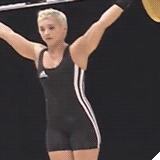Currently training for a power lifting meet and this blog is for my progress and motivationThey/them
Last active 60 minutes ago
Don't wanna be here? Send us removal request.
Text
Sweet jiu jitsu kid
3 years old kid showing great jiu jitsu techniques. So sweet I love it ❤️❤️❤️😍
892 notes
·
View notes
Link
“One emerging issue in women’s sport is the menstrual cycle and its impact on performance, player health and injury risk,” explains Dawn Scott, the USWNT’s fitness coach, exclusively to The Telegraph. “I’ve known about these effects, the research, for a long time – but working with 23 players, I had always struggled to know how to accurately monitor that and how to individualise strategies for players.”
Scott, a Brit, joined US Soccer in 2010 after almost a decade with the FA. She arrived expecting a sophisticated sports science programme given the United States’ position at the forefront of women’s football – at the time they had already won two World Cups. Instead, she found a blank canvas. “In some ways I was lucky because there was very little in place,” Scott says. “I was starting from scratch.”
The team were soon introduced to heart-rate and GPS tracking at training, added emphasis on recovery and new nutrition and hydration programmes. But after monitoring players’ periods since 2016, last year Scott decided a more advanced approach was needed. She sought additional funding from US Soccer, and brought in Dr Georgie Bruinvels from leading sports consultancy Orreco, who had just launched an initiative aimed at optimising performance among female athletes.
“Historically, players didn’t talk about their periods with coaches and support staff,” says Bruinvels. So the duo had the American national team undertake a detailed survey about their cycle and associated symptoms, and began monitoring players with the help of Orreco’s app, FitrWoman. “We then had the average cycle and duration for each player,” says Scott. “We could check when each player had symptoms at different phases of the cycle.”
Research – including Bruinvels�� doctorate – had demonstrated the adverse performance impact of various phases of the menstrual cycle. “Both from a research perspective and anecdotally, the pre-menstrual and during-menstruation phase are the worst – when hormones decline and are at their lowest level,” says Bruinvels.
But with a comprehensive understanding of each player’s cycle and related medical indicators, Bruinvels and Scott were able to develop strategies to minimise the performance impact – adjusting diets, sleeping habits, lifestyle factors and training loads for each player. “It empowered them to be proactive,” suggests Bruinvels. “There’s no evidence that someone can’t perform to their best at any time in their cycle – if they are proactive about taking steps.”
read more
483 notes
·
View notes
Text


Maybe ive smoked too much weed but I’ve always loved these freckles on my tummy because I think they look like Orion’s Belt
0 notes
Text
Guess who couldn’t sleep so only got 4 hours of sleep last night
🙋🏼♀️
0 notes
Photo




CHRIS EVANS ph. by Tony Duran for Flaunt Magazine (2004)
10K notes
·
View notes
Text

Sweet kitty, I know you want to snuggle but I need to stretch.
0 notes
Text

Today was cardio day
0 notes
Photo




Badass Female Athletes: Samantha Wright
Samantha Wright is a former competitive gymnast but has moved to competitive weightlighting. She was the coach of the USA Gymnastics team for three years, but now trains at Crossfit. She qualified to compete in the Olympics in weightlifting at the national level, so she’s a possible contender in the 2016 games. Her nickname is the Pixie Warrior, which is also pretty badass. She also placed in the top 10 at last year’s USA National Senior Weightlifting Championships. Despite her small stature, she can snatch 145 lbs. and clean and jerk 170 lbs.
17K notes
·
View notes
Text






Just finishing up my first 4 week cycle of training. Just setting down a base level of strength endurance. Next phase: hypertrophy.
0 notes


